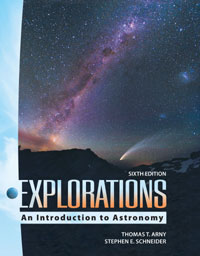 
Explorations: Introduction to Astronomy (Arny), 6th EditionChapter 5:
Telescopes  <a onClick="window.open('/olcweb/cgi/pluginpop.cgi?it=jpg::::/sites/dl/free/0010202009/220722/chapter5_1.jpg','popWin', 'width=NaN,height=NaN,resizable,scrollbars');" href="#"><img valign="absmiddle" height="16" width="16" border="0" src="/olcweb/styles/shared/linkicons/image.gif"> (156.0K)</a> <a onClick="window.open('/olcweb/cgi/pluginpop.cgi?it=jpg::::/sites/dl/free/0010202009/220722/chapter5_1.jpg','popWin', 'width=NaN,height=NaN,resizable,scrollbars');" href="#"><img valign="absmiddle" height="16" width="16" border="0" src="/olcweb/styles/shared/linkicons/image.gif"> (156.0K)</a>
 <a onClick="window.open('/olcweb/cgi/pluginpop.cgi?it=jpg::::/sites/dl/free/0010202009/220722/chapter5_2.jpg','popWin', 'width=NaN,height=NaN,resizable,scrollbars');" href="#"><img valign="absmiddle" height="16" width="16" border="0" src="/olcweb/styles/shared/linkicons/image.gif"> (115.0K)</a> <a onClick="window.open('/olcweb/cgi/pluginpop.cgi?it=jpg::::/sites/dl/free/0010202009/220722/chapter5_2.jpg','popWin', 'width=NaN,height=NaN,resizable,scrollbars');" href="#"><img valign="absmiddle" height="16" width="16" border="0" src="/olcweb/styles/shared/linkicons/image.gif"> (115.0K)</a> | |
- Understanding the Earth helps us better understand other planets.
- Scientists can determine properties of the Earth’s interior by analyzing earthquake (seismic) waves.
- The Earth’s structure consists of:
- a solid crust,
- a mantle of rocky material, and
- a core of mainly iron, part of which is liquid.
- The Earth’s interior is very hot. The heat is probably mainly left over from the time of the Earth’s formation.
- Radioactive material in the Earth contributes heat to its interior.
- Analysis of the amount of radioactivity gives the Earth’s age—about 4.6 billion years.
- Heat inside the Earth causes motions in the interior, which cause the surface to creep slowly.
- Such surface motions build mountains and alter our planet’s surface.
- Earth’s atmosphere contains mostly nitrogen and oxygen.
- The atmosphere formed from gases liberated mainly during Earth’s formation. Oxygen, however, has been added by green plants.
|
 |  |
|





